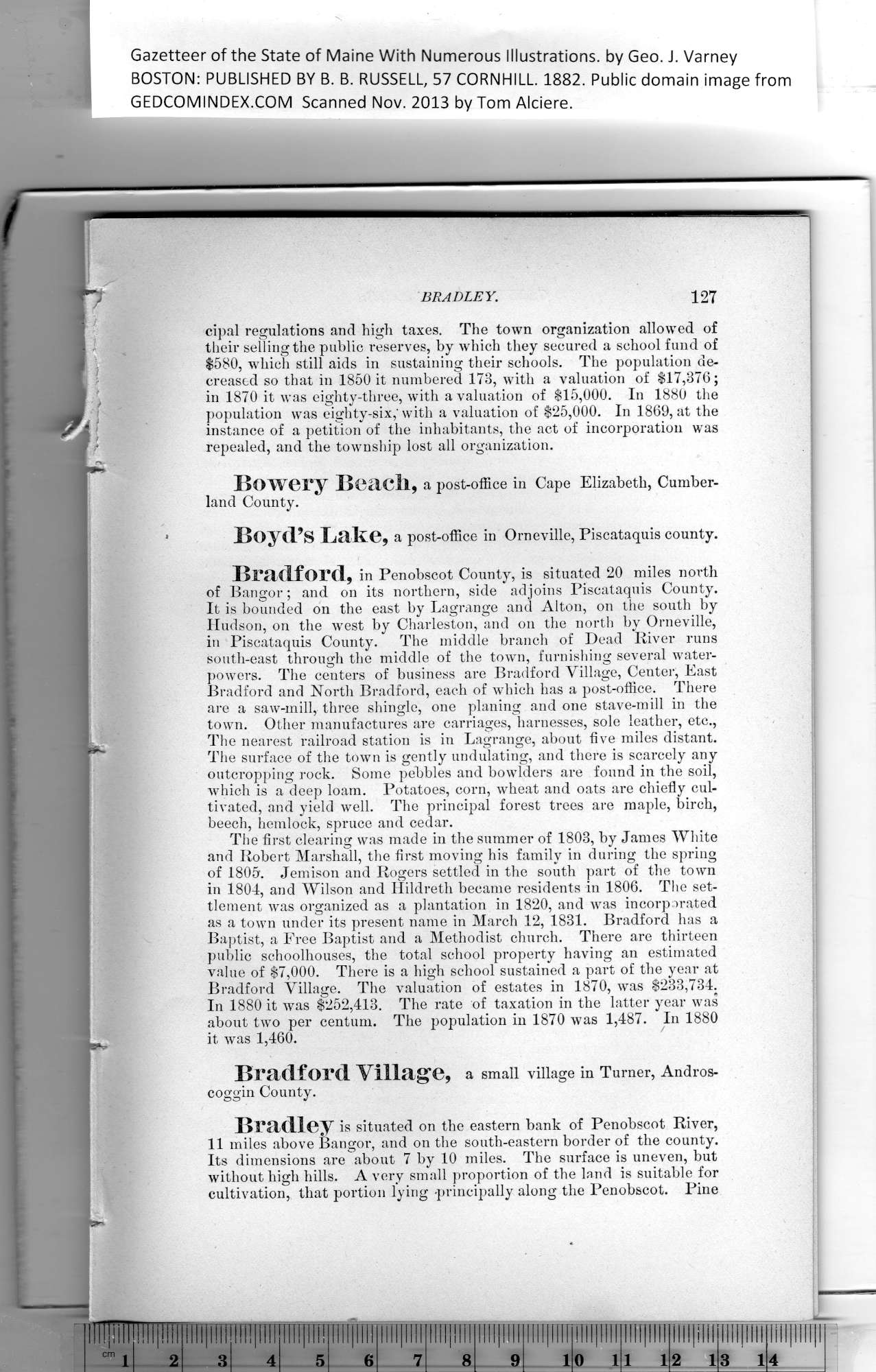|
Gazetteer of the State of Maine With Numerous Illustrations, by Geo. J. Varney
BOSTON: PUBLISHED BY B. B. RUSSELL, 57 CORNHILL. 1882. Public domain image from
BRADLEY.
cipal regulations and high taxes. The town organization allowed of
their selling the public reserves, by which they secured a school fund of
$580, which still aids in sustaining their schools. The population de-
creased so that in 1850 it numbered 173, with a valuation of $17,376;
in 1870 it was eighty-three, with a valuation of $15,000. In 1880 the
population was eighty-six,'with a valuation of $25,000. In 1869, at the
instance of a petition of the inhabitants, the act of incorporation was
repealed, and the township lost all organization.
BOWery Bench, a post-office in Cape Elizabeth, Cumber-
land County.
Boyd’S Lake, a post-office in Orneville, Piscataquis county.
Bradford, in Penobscot County, is situated 20 miles north
of Bangor; and on its northern, side adjoins Piscataquis County.
It is bounded on the east by Lagrange and Alton, on the south by
Hudson, on the west by Charleston, and on the north by Orneville,
in Piscataquis County. The middle branch of Dead River runs
south-east through the middle of the town, furnishing several water-
powers. The centers of business are Bradford Village, Center, East
Bradford and North Bradford, each of which has a post-office. There
are a saw-mill, three shingle, one planing and one stave-mill in the
town. Other manufactures are carriages, harnesses, sole leather, etc.,
The nearest railroad station is in Lagrange, about five miles distant.
The surface of the town is gently undulating, and there is scarcely any
outcropping rock. Some pebbles and bowlders are fonnd in the soil,
which is a deep loam. Potatoes, corn, wheat and oats are chiefly cul-
tivated, and yield well. The principal forest trees are maple, birch,
beech, hemlock, spruce and cedar.
The first clearing was made in the summer of 1803, by James White
and Robert Marshall, the first moving his family in during the spring
of 1805. Jemison and Rogers settled in the south part of the town
in 1804, and Wilson and Hildreth became residents in 1806. The set-
tlement was organized as a plantation in 1820, and was incorporated
as a town under its present name in March 12, 1831. Bradford has a
Baptist, a Free Baptist and a Methodist church. There are thirteen
public schoolhouses, the total school property having an estimated
value of $7,000. There is a high school sustained a part of the year at
Bradford Village. The valuation of estates in 1870, was $233,734.
In 1880 it was $252,413. The rate of taxation in the latter year was
about two per centum. The population in 1870 was 1,487. In 1880
it was 1,460.
Bradford Villag’e, a small village in Turner, Andros-
coggin County.
Bradley is situated on the eastern bank of Penobscot River,
11 miles above Bangor, and on the south-eastern border of the county.
Its dimensions are about 7 by 10 miles. The surface is uneven, but
without high hills. A very small proportion of tbe land is suitable for
cultivation, that portion lying •principally along the Penobscot. Pine
PREVIOUS PAGE ... NEXT PAGE
This page was written in HTML using a program written in Python 3.2
|
